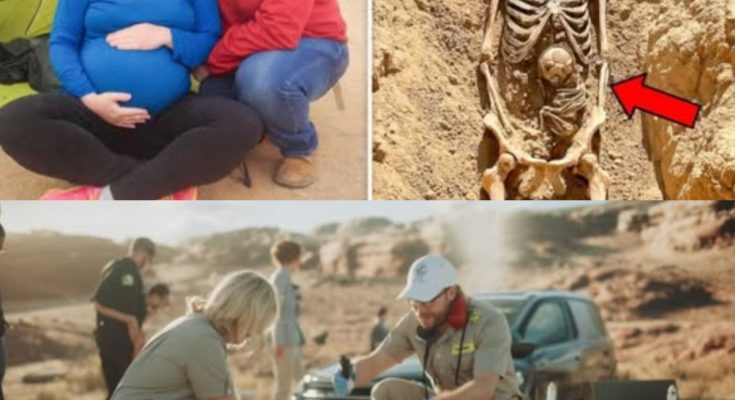Clara and Tomás were a young couple from Barcelona, Spain. Both 28 years old, they had been together for nearly a decade and were counting down the weeks until the birth of their first child — a girl they planned to name Lucía.

Before parenthood arrived, Clara had one dream: to see the desert landscapes she’d only ever seen in movies.
“I want to feel small before everything gets bigger,” she wrote in her journal, found later at their apartment in Gràcia.
Joshua Tree, with its alien beauty and solitude, seemed perfect. So, in early October 2012, they flew to Los Angeles, rented a silver Jeep Cherokee, and drove east into the Mojave Desert. They checked into a small roadside inn in Twentynine Palms, leaving most of their belongings behind before heading out for a two-day camping trip.
They were never seen alive again.
The Last Known Hours
Receipts and surveillance footage reconstructed much of their final day.
On October 6th, at 3:42 p.m., Clara bought two bottles of water, trail mix, and sunscreen at a local gas station. She was wearing a wide-brimmed hat and a loose white dress. Tomás filled up the car. They exchanged a few words with the cashier — who later described them as “smiling, polite, relaxed.”
At 5:10 p.m., a ranger’s patrol car captured their Jeep entering the Cottonwood entrance of Joshua Tree National Park.
That was the last confirmed sighting.
Silence in the Sand
When the couple failed to return their rental car or check out of the inn, the manager contacted local authorities. Within hours, a search operation began.
Over the next two weeks, hundreds of volunteers, rangers, helicopters, and trained dogs scoured the park’s vast terrain — nearly 800,000 acres of canyons, ridges, and dry riverbeds.
“We found nothing,” ranger Mark Ellison later said. “Not a shoe, not a water bottle, not a footprint. It was like they’d been erased.”
Joshua Tree’s brutal landscape became both suspect and accomplice. Temperatures can soar past 40 °C (104 °F) by day and plummet to near freezing at night. Rattlesnakes, coyotes, and hidden mine shafts make it one of the most dangerous national parks to explore off-trail.
Yet even so, experienced trackers said the complete absence of traces was highly unusual.
“Even in the harshest cases,” Ellison added, “we find something. A scrap of fabric. A signal. But not this time.”
Theories Emerge
In the months that followed, speculation filled the void left by the facts.
1. Lost and Overwhelmed
Some believed Clara and Tomás simply lost their way — perhaps wandering off a trail, disoriented by heat or dehydration. But experts pointed out that Tomás had completed military service in Spain and was trained in navigation. They had also brought a GPS and two phones.
2. Criminal Involvement
Another theory suggested they encountered someone dangerous. The region, remote and sparsely patrolled, has been linked to several cases of illegal trafficking and drug routes. But again, no evidence ever surfaced — no tire marks, no camp disturbance, no signs of struggle.
3. A Planned Disappearance
A darker rumor hinted that the couple had staged their own vanishing — perhaps to start anew elsewhere. But those who knew them dismissed the idea immediately. Clara was six months pregnant and had recently paid for a prenatal clinic back home.
“They had everything to live for,” said her best friend, Nuria Sanz. “They were planning a nursery, not an escape.”
The Desert Keeps Its Secrets
Years passed. Theories faded.
But in 2015, hikers discovered a fragment of blue fabric caught in a cactus near a remote ridge known as Dead Horse Trail, roughly 15 miles from their last known location.
DNA testing confirmed it belonged to Clara’s maternity dress — the same one seen in their final photo.
The discovery reignited the investigation. For weeks, rescue teams returned to the area, scanning with drones and ground-penetrating radar. Still, no human remains were found.
“It gave us hope and heartbreak all at once,” said Ellison. “A sign they were here… but also that they might never have left.”
A Family Still Waiting
Back in Barcelona, Clara’s parents kept her room untouched. A cradle stood in one corner, painted yellow, still wrapped in its plastic covering.
Tomás’s brother, Miguel, continues to advocate for renewed searches every anniversary.

“It’s not closure we want,” he says. “It’s truth. Even bones would be a kind of mercy.”
Every October, friends gather near the Montjuïc lookout to light candles under the couple’s photo. Locals call it “La Noche del Desierto” — The Night of the Desert.
“It’s our way of bringing them home for a few hours,” said Nuria. “Of refusing to let them vanish twice — once in the sand, and again in memory.”
Echoes and Patterns
Clara and Tomás’s disappearance joined a haunting list of mysteries surrounding Joshua Tree.
Over the past two decades, more than 700 missing-person reports have been filed in the region — many resolved, some never explained.
Journalist Ethan Burke, who documented similar cases in his 2019 book Ghosts of the Mojave, wrote:
“Joshua Tree is both graveyard and mirror — it reflects the silence of those who enter it with too much trust in daylight.”
For Burke, the case of Clara and Tomás stands out because of its emotional contrast: a couple on the brink of new life, lost in a place synonymous with desolation.
“They weren’t thrill-seekers or fugitives,” he told reporters. “They were ordinary people who just wanted to see the sunset.”
Ten Years Later
In 2022 — a full decade after they disappeared — a documentary team from Spain revisited the site, retracing their route.
At one point, filmmaker Lucía Romero (ironically sharing the name of the unborn child) filmed the exact view from their campsite. The same horizon. The same silence.
“It felt like standing inside a paused memory,” she said. “As if the desert itself refused to move on.”
The documentary, Before the Sand, premiered at the Sitges Film Festival and reignited global interest in the mystery. It closed with the couple’s final photograph fading into the desert night, accompanied by Clara’s voice from an old home video saying:
“When we come back, we’ll show our daughter where she was, even before she was born.”
What Remains
The official case remains open, classified as “missing under undetermined circumstances.”
Every few years, new hikers report possible clues — a bone, a torn strap, a glint of metal — but each lead ends in dust.
And still, Joshua Tree stands unchanged: silent, beautiful, indifferent.
In the words of one local ranger:
“The desert doesn’t take sides. It just keeps what it keeps.”
For Clara and Tomás, it became both cradle and coffin — a place where a love story and a mystery fused into one.
Their families still wait. Their photo still circulates.
And somewhere, beneath the endless blue sky of California, the wind still whispers their names.




